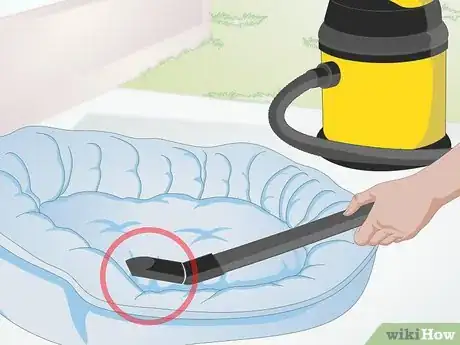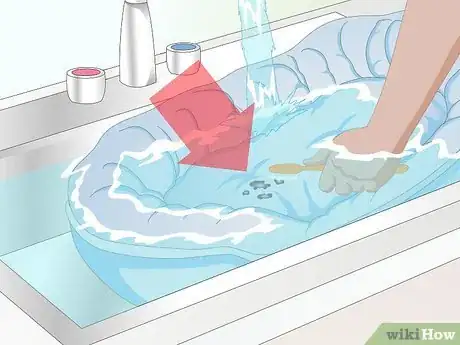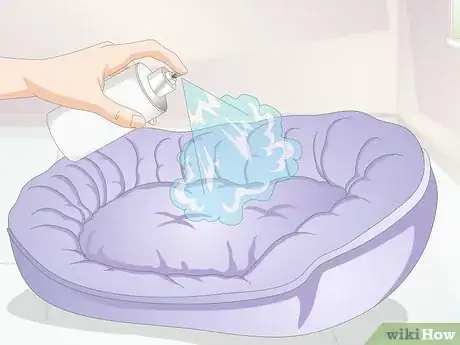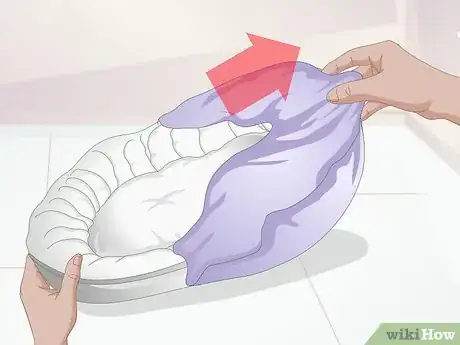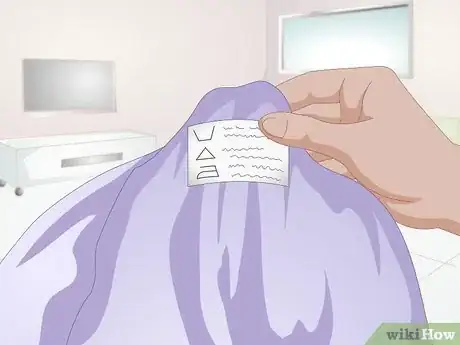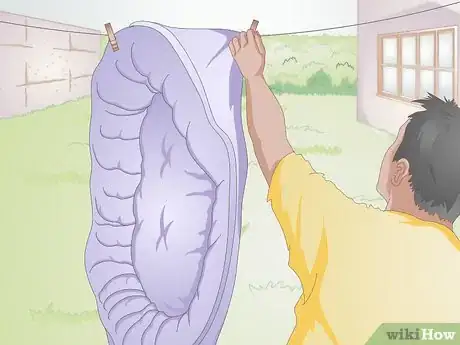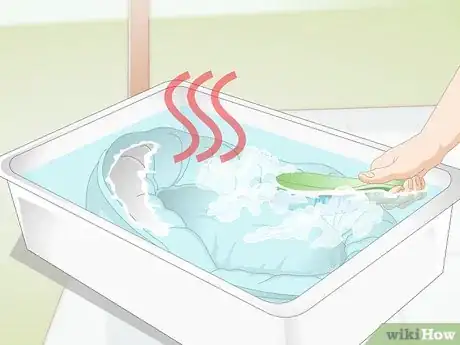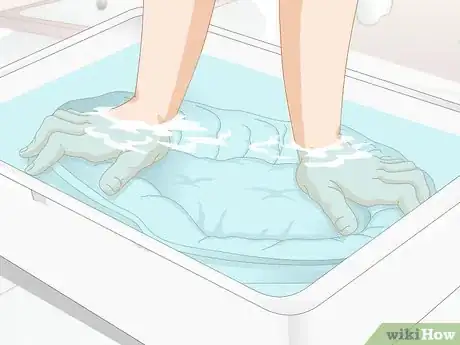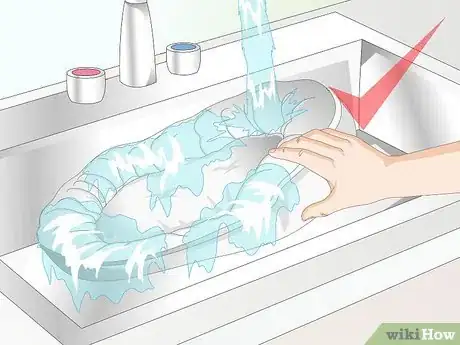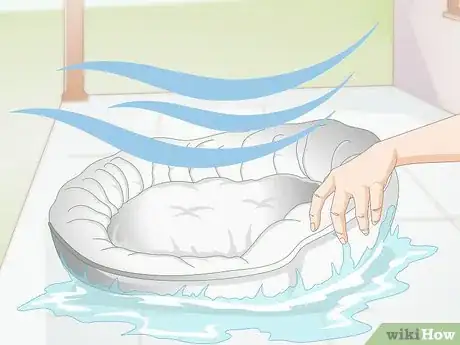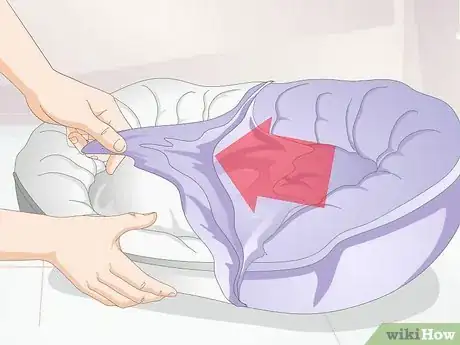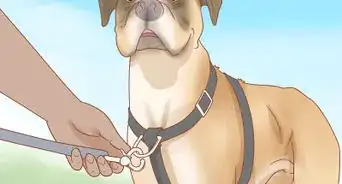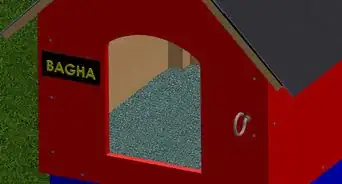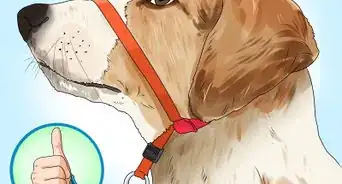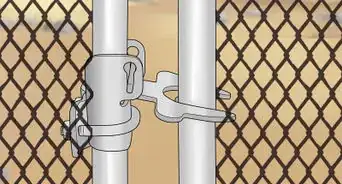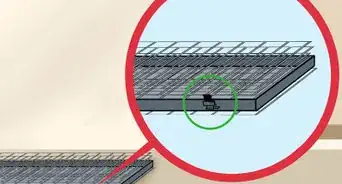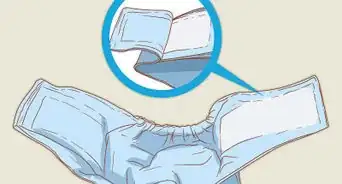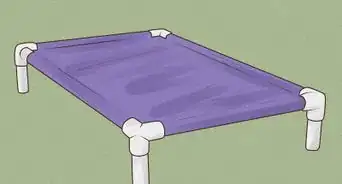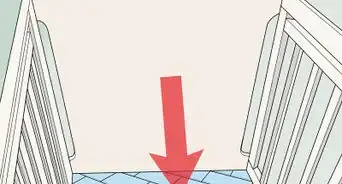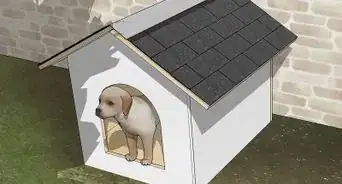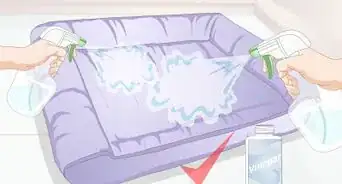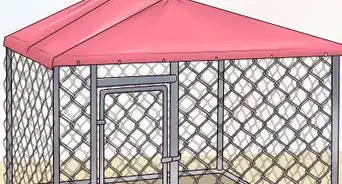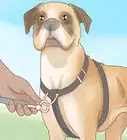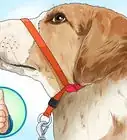This article was co-authored by Pippa Elliott, MRCVS. Dr. Elliott, BVMS, MRCVS is a veterinarian with over 30 years of experience in veterinary surgery and companion animal practice. She graduated from the University of Glasgow in 1987 with a degree in veterinary medicine and surgery. She has worked at the same animal clinic in her hometown for over 20 years.
There are 8 references cited in this article, which can be found at the bottom of the page.
This article has been viewed 40,879 times.
Your dog's bed is a cozy place for your pup to curl and get comfortable, but it is also a place where they leave their hair, saliva, dirt, and germs. Regularly cleaning your dog bed is important to help ensure that your pet stays clean, happy, and healthy. Treating the cover as well as the cushion of your bed, and addressing stains, pests, and other problems as they appear lets you keep your pet’s bed clean and ready to use whenever your dog is ready to lay down.
Steps
Removing Dirt and Debris
-
1Shake it out. Remove any large clumps of dirt or other pieces of debris by shaking out the dog bed. This is best done outdoors or in an area you don’t mind getting dirty, as it may result in dirt settling in the immediate area.
- Loosen stubborn pieces of dirt by gently beating them with a broom or stick.
-
2Vacuum the dog bed. Next, take a handheld vacuum or use a crevice attachment with your standard vacuum and vacuum out the dog bed. Focus on seams and folds in the bed, as this is where dust, debris, and other problems such as insects may hide and accumulate.[1]
- You may want to use a dusting attachment to sweep over the larger, flat parts of the dog bed, then switch to the crevice tool to clean out the stitching.
Advertisement -
3Soak stubborn areas. If you find there are patches of dirt or dried on mud that are particularly difficult to remove, treat them by placing a damp washcloth or paper towel over the area. Allow the towel to sit on top of the spot for 10 to 20 minutes, then wipe away the softened dirt using the back side of the towel.[2]
- A toothbrush may also be helpful in flaking away stubborn patches of dirt, especially if they do not wipe off after soaking.
Treating Spots and Stains
-
1Check for spots. If you notice spots or staining on your pet's bed, treat them before you wash the liner. In general, it is not advisable to treat cosmetic staining on the cushions of the bed using chemical spot treatments. This is because the treatment may not rinse thoroughly out of the filling and the residue can be irritating to your dog's skin. Only treat if you believe a stain has the potential to be harmful, such as blood or vomit from another dog.
- For cosmetic stains, simply rinse out the stain as best as possible using soap and water.
- Use a non-bleach spot treatment product as much as possible. These can easily be found at local markets and pet shops. Follow the directions for pre-treatment according to the product bottle.
- If you must use bleach, look for a chlorine-free bleaching agent, and remember to rinse thoroughly and completely before washing. Such bleaches can often be found at health food and natural food stores.[3]
-
2Treat potential insect infestation. If you have any concerns regarding pests or insects in your pet’s bed, treat immediately by soaking all parts of the bed in boiling water. Allow it to sit in the boiling bath for three to five minutes to fully kill any pests and their larvae.[4]
- Watch your bed carefully as you boil it. Make sure it does not start breaking apart or disintegrating due to high temperatures.
- Do not leave your bed in a boiling bath for extended periods of time, as this could cause the filling to melt.
- Treat your dog for any infestation it might have before you allow it to use the bed again.
-
3Spray for odor. Once your bed is completely treated, use a pet-friendly odor absorbing spray to treat for any residual odor and to help decrease new smells. Spray the bed lightly with the product, as heavy application may bother your dog’s sensitive nose.[5]
- These products are readily available from your local pet store as well as your vet’s office.
- Talk to your vet if your dog has any allergies or has sensitive skin.
Cleaning the Cover
-
1Remove the cover. While both the inside and the outside of the dog bed need to be cleaned, the cover sees the most wear and tear from your dog. Remove the cover, if possible, and re-zip the cover without the cushion to prevent the zipper from snagging during cleaning.
- If your dog bed does not have a removable cover, clean the entire bed the same way you would clean the inside cushion.
-
2Read the tag. Make sure your cover can be washed in a standard, household washing machine. If the cover says hand-wash only, remember to use a low, hand-wash setting on your washer, or otherwise manually wash the cover.
- Look for any restrictions regarding water temperature or drying the cover before you wash it.
-
3Wash the cover. Run your cover through the washing machine in accordance with the tag, using hot water and pet-friendly detergent. Look for a detergent that is environmentally-friendly and scent-free, or check with your local pet store to find products especially formulated for pets.[6]
- If your pet has sensitive skin or is prone to allergies, ask your vet for recommendations for proper products.[7]
- If the tag on the cover states that it should be washed in warm or cool water, soak the liner in boiling hot water for 2 minutes before washing to disinfect it. Disinfecting for short periods is necessary to kill the microbes on the bed before washing the bed for an extended period at a cooler temperature. Watch carefully to avoid damage to the cover.
-
4Dry the cover. Dry the cover according to the laundry tag information. If possible, try to dry the cover on a normal or permanent press setting in your dryer. If the cover must be air-dried, hang it down from a rod or laundry line and pin it in place.[8]
- Try not to fold an air-drying cover over onto itself, as this will increase drying time.
Cleaning the Cushion
-
1Soak the cushion. If your dog bed cushion need washing, hand wash it with hot soapy water in your tub or a basin using a dog-friendly detergent. Begin by allowing it to soak in very hot water to disinfect it. Leave it in the basin until the water cools enough for you to comfortably work in it.
- Look for a detergent that is formulated for hand-washing. These are often available at local grocery and home goods stores, and will have indicators on the box.
-
2Agitate the bed. Once you are done soaking the bed, use your hands to gently agitate it. Squeeze and wring the bed under water to loosen any dirt that may have settled in the cushion. Be sure to get all parts of the cushion.
- There is no set time for how long you should agitate the cushion, but you should not stop until you see the dirt moving from the surface of bed. Treat all parts of the bed before rinsing.
-
3Rinse out the cushion. Wring out the soap and rinse with fresh water. Run the bed under a faucet of warm, fresh water and continue to wring and squeeze the cushion until it stops sudsing and all the soap has been removed. Then, wring the fresh water from the bed as much as possible.[9]
- You will likely not be able to remove all water from the bed manually. However, the cushion should be damp, rather than wet, and no longer dripping before you stop wringing it and allow it to dry.
-
4Let air dry. Set the cushion out on a flat surface that you don’t mind getting wet, or extend it fully across the top of a drying rack. Allow the cushion to air dry completely before re-covering it. This may take upwards of a full day.
- Check to see if the bed is dry by pressing down firmly in an area where the filling is thickest. If it spills out water or still feels damp, allow the cushion to continue to dry.
- If certain spots are drying slowly, use a hair dryer on a low setting to help dry them faster.
-
5Fluff and reassemble. Once both your cushion and your cover are dry, you can put the dog bed back together. Fluff the cushion by pulling gently at the filling with both hands in areas where it has become compact. Then, insert the cushion back in the liner, and the bed is ready for your pet to enjoy.
- Ensure that you fully close any zippers on your liner to prevent the excess accumulation of dust and keep out insects and pests that could bother your pet.
Warnings
- Be sure to read all cleaning instructions before running your liner through your washer. Not all dog bedding is machine washable. Look for washable liners if you are buying a new one.⧼thumbs_response⧽
References
- ↑ http://blog.mollymaid.com/2015/06/29/how-to-wash-a-smelly-dog-bed/
- ↑ https://www.speedqueen.com/support/stain-removal-guide.aspx
- ↑ http://www.brighthub.com/environment/green-living/articles/22911.aspx
- ↑ https://www.petcarerx.com/article/how-do-dogs-get-fleas/164
- ↑ http://dogtime.com/how-to/home-cleaning/3214-how-to-clean-foam-dog-beds
- ↑ http://www.petmd.com/dog/care/evr_dg_guide-to-washing-dog-bed
- ↑ http://dogtime.com/how-to/home-cleaning/3483-cleaning-supplies-for-your-pet-friendly-home
- ↑ https://www.westpawdesign.com/content/care-instructions-stuffed-pet-beds
- ↑ http://dogtime.com/how-to/home-cleaning/3214-how-to-clean-foam-dog-beds
About This Article
To remove surface dirt and debris from your dog’s bed, carry the bed outside and shake it. If any debris sticks to the bed, you can loosen it by hitting the bed with a broom. Once you’ve removed the loose dirt, go over the bed with a vacuum cleaner to get rid of more settled-in dust and grime. To loosen the most stubborn dirt or patches of dried on mud, place a damp towel or washcloth over the spot for 10-20 minutes and then gently scrub it with a cloth or an old toothbrush. Keep reading for more advice from our Veterinarian co-author, including how to get rid of spots and stains!

